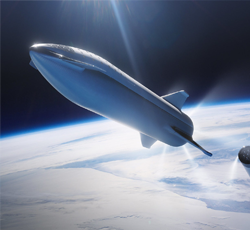
With Block 5, SpaceX to increase launch cadence...
- by NASASpaceFlight.com
- May 17, 2018
- 0 Comments
- 0 Likes Flag 0 Of 5

On May 15th, the Block 5 from the Bangabandhu mission – designated B1046 – arrived in Port Canaveral. The arrival allowed for the first look at Block 5’s post-landing operations.
A new lifting cap is lowered onto B1046’s interstage. Credit: Marek Cyzio for NSF L2
One of the most notable changes was a new lifting cap which allows a crane to transport the booster. The cap appeared to be an upgrade from the one used for previous cores. Notable changes included several new cameras and sensors.
Additionally, Musk had also mentioned that Block 5’s landing legs have “an internal latch which can be opened and closed repeatedly with ease. Essentially, deploying the landing gear and stowing the landing gear is now a very easy thing to do, whereas previously it required several hours to restow the landing gear.”
Therefore, it was expected that SpaceX would not remove the landing legs on B1046. Surprisingly, they did remove the landing legs.
The new Block 5 landing legs support B1046 on the droneship. Credit: Marek Cyzio for NSF L2
One reason is that SpaceX will have to wait for the next Block 5 launch to demonstrate how quickly a booster can turn around for another flight. According to Musk, they “need to take this rocket apart to confirm that it does not need to be taken apart.”
Consequently, “this [B1046] won’t refly for a couple months.”
Low cost:
Due to the Block 5’s reusability, SpaceX has lowered the standard price of a Falcon 9 launch from $62 million to about $50 million. This move further strengthens SpaceX’s competitiveness in the commercial launch market.
In fact, even at the $62 million price point, SpaceX was already starting to win contracts that would have previously gone to competitors such as Arianespace.
As for Falcon Heavy, SpaceX is yet to release the updated price for the Block 5 version. However, Falcon Heavy – which was priced at $90 million – uses three first stage cores instead of one. Everything else about the rocket is the same as Falcon 9. Therefore, in all likelihood, the price of Falcon Heavy will drop by a larger margin than it did for Falcon 9.
Half of a payload fairing returns to Earth via parafoil. Credit: Elon Musk
In the future, SpaceX’s launch prices could become even cheaper. The company is currently working on recovering the payload fairing which is worth approximately $6 million.
That leaves only the second stage without a recovery plan.
While the Block 5 second stages are not currently outfitted with recovery hardware, it is something that is under consideration.
Musk said last week, “in the upcoming flights [SpaceX will] gather data about the reentry experience of the upper stage. Previously, we had not put a lot of effort into gathering data from the upper stage after it does its disposal burn. We will monitoring at what altitude and speed the stage breaks up…”
Collecting this data is not easy. Musk explained that “it’s tricky because it comes in like a meteor. It’s sort of like a ball of plasma. You can only broadcast diagonally backwards, so we will be looking to communicate, probably [with] the Iridium constellation, and try to transmit basic data about temperature, basic health of the stage, velocity, and altitude.”
SpaceX will try to bring rocket upper stage back from orbital velocity using a giant party balloon
Please first to comment
Related Post
Stay Connected
Tweets by elonmuskTo get the latest tweets please make sure you are logged in on X on this browser.
Sponsored
Popular Post
Sam Altman's OpenAI Takes On Elon Musk's Grok in AI Chess Tournament Final - Who Won?
28 ViewsAug 09 ,2025






 Energy
Energy


















